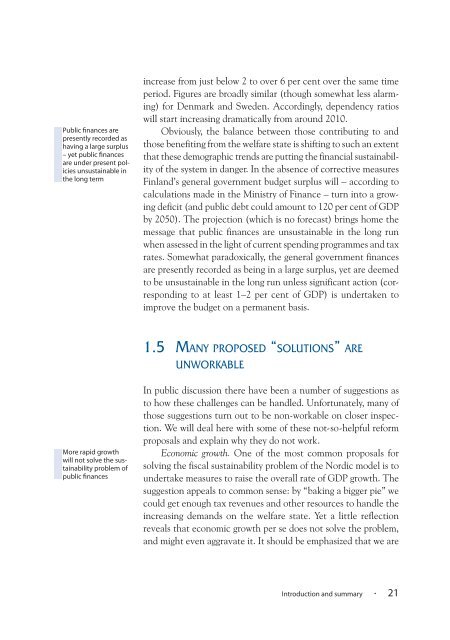The Nordic Model - Embracing globalization and sharing risks
The Nordic Model - Embracing globalization and sharing risks
The Nordic Model - Embracing globalization and sharing risks
You also want an ePaper? Increase the reach of your titles
YUMPU automatically turns print PDFs into web optimized ePapers that Google loves.
Public finances are<br />
presently recorded as<br />
having a large surplus<br />
– yet public finances<br />
are under present policies<br />
unsustainable in<br />
the long term<br />
increase from just below 2 to over 6 per cent over the same time<br />
period. Figures are broadly similar (though somewhat less alarming)<br />
for Denmark <strong>and</strong> Sweden. Accordingly, dependency ratios<br />
will start increasing dramatically from around 2010.<br />
Obviously, the balance between those contributing to <strong>and</strong><br />
those benefiting from the welfare state is shifting to such an extent<br />
that these demographic trends are putting the financial sustainability<br />
of the system in danger. In the absence of corrective measures<br />
Finl<strong>and</strong>’s general government budget surplus will – according to<br />
calculations made in the Ministry of Finance – turn into a growing<br />
deficit (<strong>and</strong> public debt could amount to 120 per cent of GDP<br />
by 2050). <strong>The</strong> projection (which is no forecast) brings home the<br />
message that public finances are unsustainable in the long run<br />
when assessed in the light of current spending programmes <strong>and</strong> tax<br />
rates. Somewhat paradoxically, the general government finances<br />
are presently recorded as being in a large surplus, yet are deemed<br />
to be unsustainable in the long run unless significant action (corresponding<br />
to at least 1–2 per cent of GDP) is undertaken to<br />
improve the budget on a permanent basis.<br />
1.5 MANY PROPOSED “SOLUTIONS” ARE<br />
UNWORKABLE<br />
More rapid growth<br />
will not solve the sustainability<br />
problem of<br />
public finances<br />
In public discussion there have been a number of suggestions as<br />
to how these challenges can be h<strong>and</strong>led. Unfortunately, many of<br />
those suggestions turn out to be non-workable on closer inspection.<br />
We will deal here with some of these not-so-helpful reform<br />
proposals <strong>and</strong> explain why they do not work.<br />
Economic growth. One of the most common proposals for<br />
solving the fiscal sustainability problem of the <strong>Nordic</strong> model is to<br />
undertake measures to raise the overall rate of GDP growth. <strong>The</strong><br />
suggestion appeals to common sense: by “baking a bigger pie” we<br />
could get enough tax revenues <strong>and</strong> other resources to h<strong>and</strong>le the<br />
increasing dem<strong>and</strong>s on the welfare state. Yet a little reflection<br />
reveals that economic growth per se does not solve the problem,<br />
<strong>and</strong> might even aggravate it. It should be emphasized that we are<br />
Introduction <strong>and</strong> summary · 21

















